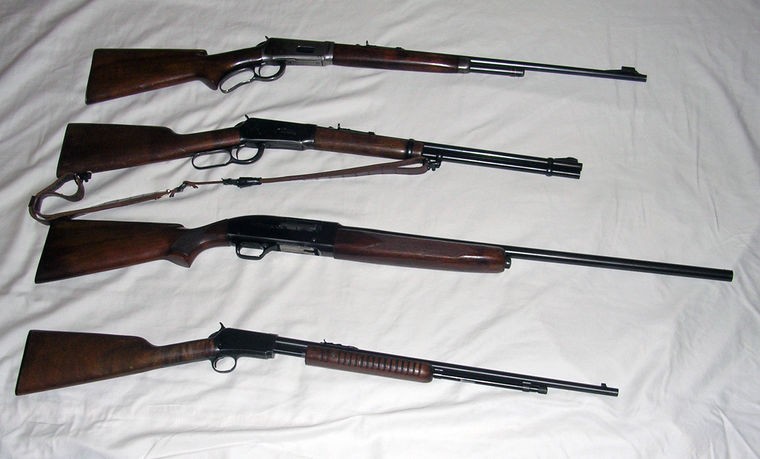In 1855, a clothing manufacturer named Oliver Winchester became the largest stockholder of the Volcanic Repeating Arms Company, which was developing the Volcanic Lever Action Rifle.
The rifle had only limited success and the company fell into bankruptcy. Oliver Winchester and his partner, John M. Davies, purchased the company’s assets and reorganized it as the New Haven Arms Company in April 1857.
With the help of Benjamin Henry, the New Haven Arms Company developed the .44 Henry round and a lever-action rifle loosely based on the Volcanic that could use the new round. It retained only the general form of the breech mechanism and the tubular magazine.
Thus, the Henry rifle of 1860 was born and was used by some Union army units in the Civil War. The Henry rifle ensured success for New Haven Arms and established the lever-action repeater in the firearms market.
In 1866, a dispute between Henry and Winchester over compensation prompted Winchester to reorganize New Haven Arms again into the Winchester Repeating Arms Company. Winchester completely redesigned and improved the Henry rifle design, creating the 1866 Winchester rifle, which fired the same .44 caliber cartridge but had an improved magazine and loading gate.
In 1873, Winchester introduced the Model 1873 in 44-40 WCF (Winchester Center Fire). The 1873 Winchester became known as the gun that won the West.
The 1873 was followed by the 1876 Winchester, which was a little larger and chambered longer to fire .45-60 WCF, .50-95 and the .45 70 Government cartridges. However, the 1876 Winchester rifle would not handle the .45-70 Government cartridge, so Winchester Repeating Arms developed the Model 1886 Winchester rifle.
Oliver Winchester and his son didn’t live to see the 1886 rifle’s introduction as Oliver died in December 1880 and his son died four months later.
In the early years of the 20th century, Winchester Repeating Arms met heavy competition from John Browning designs manufactured under license by other firearm companies. The race to produce the first self-loading rifle saw the development of the Winchester Model 1903, Winchester Model 1907 and Winchester Model 1910 rifles.
Winchester ws a major producer of the .303 Pattern 1914 Enfield rifle for the British government and the similar .30-06 M1917 Enfield rifle for the United States during World War I. Working at the Winchester plant during that war, John Browning developed the final design of the Browning Automatic Rifle. Browning and Winchester engineers also developed the .50 caliber machine gun and its 12.7 x 99 ammunition. The commercial rights to these new Browning guns were owned by Winchester.
During World War II, an eight-man team designed the U.S. M1 Carbine, produced the M1 Garand and was the first manufacturer of the M14 Rifle.
After WWII, Winchester started having financial difficulties, and by the 1960s, the cost of skilled labor was making it unprofitable to produce Winchester’s classic designs, as they required considerable handwork to finish.
Although the Model 70 rifle in various calibers was one of America’s favorite hunting rifles and several of their shotguns were well-received, lever-action rifles with tubular magazines required bullets that were blunt enough not to set off the primer of the cartridge in front of them in the tubular magazine during firing. American hunters were starting to favor bolt-action rifles that fired longer, more streamlined bullets.
The Model 94 Winchester lever-action rifle in .30-30, which came out in 1895 and was the first Winchester smokeless powder cartridge, sold well into the 1950s and ‘60s, earning the distinction of America’s favorite deer rifle for the first half of the 1900s.
On Jan. 16, 2006, Winchester announced it was closing its plant New Haven, Connecticut where Winchester rifles and shotguns had been produced for over 140 years.
On Aug. 15, 2006, the Olin Corporation, the owner of the Winchester trademark, announced that it had entered into a new license agreement with Browning to make Winchester brand rifles and shotguns.
In the summer of 2008, Fabrique Nationale d’Herstal resumed production of Model 70 rifles in Columbus, South Carolina. Later in 2010, Fabrique Nationale d’Herstal resumed production of the 1894 lever-action rifle. So most of the Winchester firearms of the past are now available again, although at high prices.
I feel fortunate to have three Winchester rifles and a shotgun that were produced between 1935 and 1955. A company that has been manufacturing rifles and shotguns for 151 years has got to be doing a lot of things right.
Smokey Merkley was raised in Idaho and has been hunting since he was 10 years old. He was a member of the faculty of Texas A&M University for 25 years. There he taught orienteering, marksmanship, self-defense, fencing, scuba diving and boxing. He was among the first DPS-certified Texas Concealed Handgun Instructors. He can be contacted at mokeydo41245@hotmail.com.



